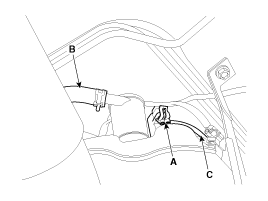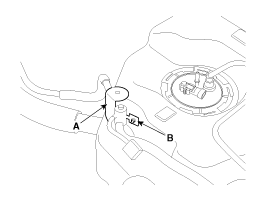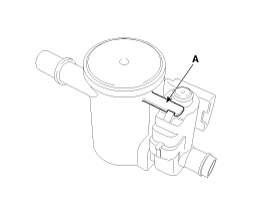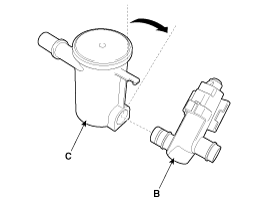 Kia Sportage: Canister Close Valve (CCV): Repair procedures
Kia Sportage: Canister Close Valve (CCV): Repair procedures
Third generation SL (2010Ц2016) / Kia Sportage SL Service & Repair Manual / Engine Control / Fuel System / Engine Control System / Canister Close Valve (CCV): Repair procedures
| Inspection |
| 1. |
Turn the ignition switch OFF. |
| 2. |
Disconnect the CCV connector. |
| 3. |
Measure resistance between the CCV terminal 1 and 2. |
| 4. |
Check that the resistance is within the specification.
|
| 5. |
Disconnect the vapor hose connected with the canister from the CCV. |
| 6. |
Connect a vacuum pump to the nipple. |
| 7. |
Ground the CCV control line and apply battery voltage to the CCV power supply line. |
| 8. |
Apply vacuum and check the valve operation.
|
| Removal |
| 1. |
Turn the ignition switch OFF and disconnect the battery negative (-) cable. |
| 2. |
Lift the vehicle. |
| 3. |
Disconnect the canister close valve connector (A). |
| 4. |
Disconnect the ventilation hose (B,C) from the fuel tank air filter and canister close valve.
|
| 5. |
Remove the fuel tank air filter and canister close valve assembly (A) after removing the mounting nut (B).
|
| 6. |
Release the lever (A), and then separate the canister close
valve (B) from the fuel tank air filter (C) after rotating it in the
direction of the arrow in the figure.
|
| Installation |
|
| 1. |
Installation is reverse of removal. |
 Canister Close Valve (CCV): Schematic Diagrams
Canister Close Valve (CCV): Schematic Diagrams
Circuit Diagram
...
Other Information:
Troubleshooting
Troubleshooting Guide
Before Thinking The Product Has Malfunctioned
1.
Errors which occur during the operation or installation of the device may be mistaken as a malfunction of the actual device. ...
Antenna: Repair procedures
Inspection
Antenna Cable
1.
Remove the antenna jack from the audio unit and antenna.
2.
Check for continuity between the center poles of antenna cable.
3.
Check for continuity between the ...
Categories
- Home
- Kia Sportage QL (2015-2019) Owners Manual
- Kia Sportage QL (2015-2019) Service Manual
- Kia Sportage SL 2010-2016 Owners Manual
- Kia Sportage SL 2010-2016 Service Manual
Copyright © www.kispmanual.com 2014-2025






